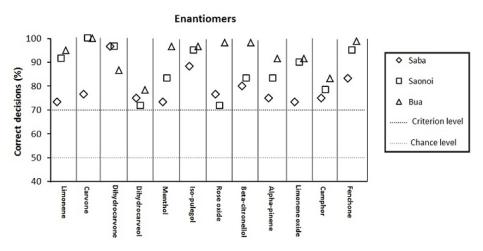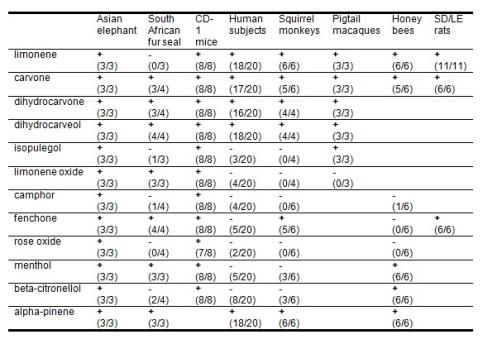Odor discrimination with enantiomers
The three elephants Saba, Saonoi and Bua were presented with 12 enantiomeric odor pairs. The enantiomers of limonene, carvone, dihydrocarvone, dihydrocarveol, limonene oxide, alpha-pinene, menthol, camphor, beta-citronellol, rose oxide, iso-pulegol and fenchone were used.
All three elephants performed above criterion level (p<0,05) in all 12 discrimination tasks and thus were clearly able to discriminate between all enantiomeric odor pairs presented.
The graph shows the results from the two sessions combined.

The same odorants have previously been tested with humans (Laska and Teubner 1999), squirrel monkeys (Laska et al. 1999b; Laska et al. 2005), pigtail macaques (Laska et al. 2005), South African fur seals (Kim 2012), mice (Laska and Shepherd 2007), honeybees (Laska and Galizia 2001; Laska et al. 1999) and SD/LE rats (Linster et al. 2001; Rubin and Katz 2001). This allows for direct comparisons of olfactory discrimination performance between species.
The “+”-symbol stands for a species being able to discriminate between the enantiomeric pair, The “-“-symbol stands for a species not being able to discriminate between the enantiomeric pair and the empty space means that the enantiomeric pair was not tested with this species.
The numbers in brackets show how many out of the total number of animals tested with each species succeeded in discriminating between the given enantiomers.

Several of the enantiomeric pairs tested here such as carvone, limonene and alpha-pinene are found in a variety of food plants (König et al. 1990; Mosandl et al 1990) which may explain why a plant eating species as the elephant is able to recognize and discriminate them. Enantiomers such as rose oxide, for which only one of the two forms has been found in nature, in contrast, are almost never found in essential oils (König et al. 1990; Mosandl et al 1990). This is also shown by the discrimination performance where several species had difficulties discriminating it.
Responsible for this page:
Director of undergraduate studies Biology
Last updated:
